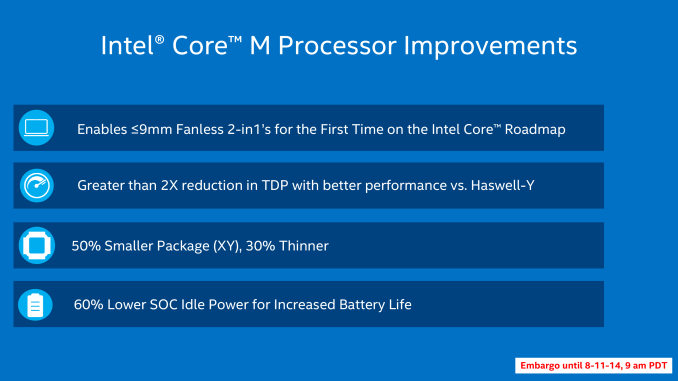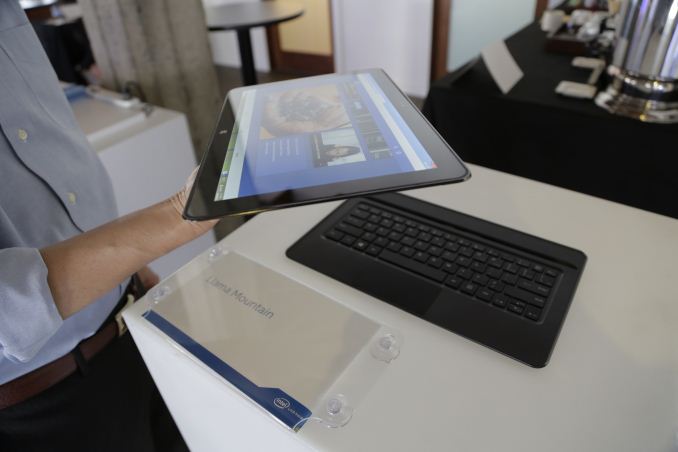Intel Broadwell Architecture Preview: A Glimpse into Core M
by Ryan Smith on August 11, 2014 12:01 PM ESTClosing Thoughts
Wrapping up our preview of the Broadwell architecture and Intel’s Core M processor, the bulk of Intel’s presentation and focus today is on the latter, so that is where we’ll start.
Core M is not a make-or-break product for Intel, but none the less it is a very important one. Mobile devices – be it tablets, slates, transformers, 2-in-1s etc – are continuing to increase in popularity, and as we’ve seen with ARM based tablets so far they form a market that has continued to grow and continued to erode the x86 laptop market that Intel has dominated for so long. Though laptops as a category are not going anywhere any time soon, their erosion means that Intel needs to get into mobile devices if they want to maintain their sales and their stature. To that end it’s not too late for Intel to break into this market and turn things around, but if they’re going to succeed then they need to make their move sooner or later, and this is where Core M fits in.
It’s telling then that while Intel is going after this market with a Core architecture, they are doing so under a different Core brand. Core M doesn’t just represent a new low powered Core CPU, but in Intel’s eyes is another product entirely. One that is so different that it does away with the Core i3/i5/i7 convention entirely and gets its own brand name and own product numbers. Core M is still Core, but it is nearly unrecognizable compared to the Core of even 4 years ago.
As far as the Core M product is concerned then, while Intel’s plans are grand they are not without merit. Backed by Intel’s new 14nm process and the Broadwell architecture, Core M looks like it should finally resolve the issues that dogged even Haswell-Y by bringing down power consumption even further while improving on Intel’s already strong performance, and getting the resulting processor in an SoC small enough to be usable in even the thinnest mobile devices. In fact from a technical perspective there’s little reason to doubt Core M; we’ll still have to wait to see just how good the resulting retail products are, but there shouldn’t be any technical reason for why it can’t be put into a mobile device comparable to today’s 10”+ tablets. Intel’s own Llama Mountain reference design can vouch for that much, showcasing the viability of Core M in a 12.5” tablet that’s just 7.2mm thick.
Intel's Llama Mountain, a Core M form factor reference design
More likely what will determine Core M’s fate and Intel’s ability to completely break into the mobile device market will be pricing. Intel’s profit margins are somewhat legendary in the computer industry, and a big part of that profitability has come from the high prices Intel has enjoyed from products such as their Core processors. Core M, like the other Cores before it, will still be an upscale product – a higher priced, higher performance alternative to Intel’s mass-market Atom processors. And while that makes plenty of sense on paper, in the real world Intel has to face the AllWinners and other ARM vendors of the world who are happy to sell their ARM SoCs at significantly lower margins, which can have a knock-on effect even if they can’t compete with Intel on overall performance. At this point it’s far too early to call this, especially when Intel isn’t even discussing Core M pricing at this time, but it’s a subject that Intel will have to consider carefully as “good enough” ARM devices will continue to be the biggest threat to Intel’s position in the CPU market.
Moving on, while today’s release from Intel only offers us a preview of what Intel will be delivering with their Broadwell architecture, what Intel has presented thus far looks to continue Intel’s tradition of relentless execution. As a tick Broadwell is a small but respectable improvement in Intel’s Core architecture, with the expected 5% IPC improvement in-line with previous ticks. For more traditional desktops and laptops it won’t radically change the world, but then it never was meant to. The biggest question for these parts will be whether Broadwell will improve on Haswell’s clockspeeds at all – a clockspeed boost made possible by Intel’s 14nm process – or if we’re going to hold steady similar to what we saw with the last tick, Ivy Bridge.
Meanwhile Broadwell’s GPU improvements are more significant, and in the race to further improve what’s essentially the baseline for PC GPU performance it is always welcome. Furthermore the fact that Intel is now at API feature parity with discrete GPUs is a big deal for Intel and it is a big deal for iGPUs as a whole. What we still want to see is more performance; a single slice seems just about right for Core M, but if we’re talking about larger laptop and desktop parts it would be very nice to see something akin to GT3 become baseline, especially with the die size savings Intel will be seeing from the 14nm process.
Finally, from here the rest of Intel’s 2014 should be rather busy. Next month is Intel’s Fall IDF 2014, at which point we expect we’ll be given a deeper look at Broadwell’s architecture. Past that the first Broadwell-Y based Core M processors will be on the shelves for the holidays, and with it our chance to see Broadwell and Intel’s 14nm process in action. However that will also be our only chance to see Broadwell in action this year; while Core M will ship in time for the holidays, the rest of the Broadwell lineup will not appear until 2015.













158 Comments
View All Comments
Jaybus - Thursday, August 14, 2014 - link
TDP is "Total Dissipated Power" and as used in describing processors refers to the maximum instantaneous power that the processor will dissipate. Watt, being a unit unit of power, is the only SI unit suitable for specifying TDP. Since nearly all of the energy expended by a processor is due to heat transfer, a Watt is in this case essentially a measure of the rate of heat transfer, and TDP is the rate of heat transfer required when operating the processor at or near its maximum operating temperature.473NG3R - Friday, August 15, 2014 - link
@Jaybus Nope. Please don't correct people with false info. TDP is Thermal Design Power, and it is NOT "peak" power. It is used for marketing as mkozakewich said above as the definition of TDP measurement varies from company to company.473NG3R - Friday, August 15, 2014 - link
Oops! I read mkozakewich comment backwards. It is a marketing term in a sense... It is used to design cooling systems but it gets thrown around by marketing groups all the time since TDP limits how small a device can be.frostyfiredude - Monday, August 11, 2014 - link
With all these reductions in power use on a per core basis and a stagnation of clock speeds we very well could see a quad core i7-5770k with a 65W TDP. I hope Intel plans on bumping up their mainstream high end SKUs to six core, the desktop market doesn't need maximum power use that low.klmccaughey - Monday, August 11, 2014 - link
Yes this worries me too. I think we will see yet another pointless desktop release, with hardly any improvements (once you consider the bad overclocking).I still don't see a desktop Broadwell replacing my 2500k, which runs low(ish) heat at 4.3GHz. What I would love to see is a 5.5GHz Broadwell monster, otherwise I will be skipping broadwell, just like Hazwell and IB before it.
Surely there has to be some light on the horizon for us gamers?!
mapesdhs - Monday, August 11, 2014 - link
And someone in your position also of course has the double irony of still having more
performance headroom if they're willing to explore better cooling, etc. H80i would let
your 2500K run at 5GHz no problem, assuming your particular sample isn't naturally
limited in some way (actually, even an old TRUE and two typical fans would be fine,
something I can confirm as I've done it with several different 2700Ks, never mind a
2500K, so I know the heat isn't an issue). Thus, except for threaded workloads, an
upgrade would have to be a lot better than what you already have in order to be
worth bothering with, except if you wanted something new due to newer tech sych
as PCI Express, M.2, etc.
Anyway, this is why IB was so bad with its default metal cap setup, ie. Intel made SB
too good which resulted in lots of 2500K owners just not seeing the point in upgrading.
Thing is, they've still not boosted performance enough to make upgrading worthwhile
for most SB users (the exception of course being non-K owners).
My 2700K runs at 5.0. Takes me 3 mins to set this up on an ASUS M4E, ludicrously
easy to do. HW at 4.5 is about the same or a bit quicker, but much more complex to
do, given how many samples won't go that high, and for gaming it makes no difference
at all. I suppose the 4790K can help on the oc front a bit, but the cost has put me off so
far, used 2700Ks are so much cheaper. I want to build a 4K gaming system next, but
that'll be X99 instead I think (don't see the point of mainstream chipsets for 4K gaming,
surely with multiple GPUs the limited PCIe lanes is going to hold back performance
eventually).
Ian.
garadante - Tuesday, August 12, 2014 - link
I wish I had your luck with SB. My 2500k will only do 4.5 GHz stable with 1.365 vcore (in reality, monitoring software reports 1.391~ vcore with my motherboard's way of handling vdroop). If I could go any higher, I'd have to dump a load of voltage into it that I'm just afraid of doing. Though this may be a motherboard problem as it's given me problems before, but that still wouldn't account for a 500 MHz variance. I guess I just got a bad SB. :/pt2501 - Monday, August 11, 2014 - link
You said it. My 2500k at 4.6 Ghz isn't going anywhere unless something revolutionary is released. Best processor I ever bought.ZeDestructor - Monday, August 11, 2014 - link
They want you to go up to LGA2011 for the solder-based TIM. And only because of die-cracking issues (I found the papers covering that) on smaller dies that force them to use boring old polymer TIM.steve wilson - Tuesday, August 12, 2014 - link
My thoughts exactly. My 2500k runs everything fine for me at 4.4ghz. I will be skipping Broadwell and praying Skylake will deliver.